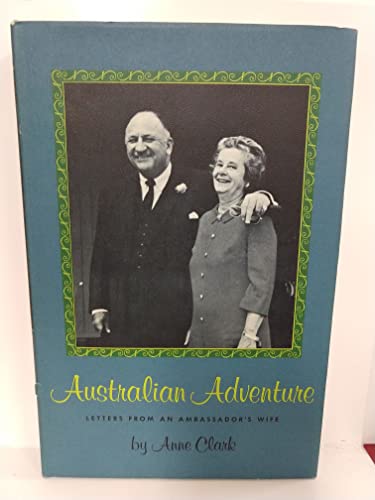Anne Clark, Australian Adventure: Letters from an Ambassador’s Wife (1969)
For all the great strides that Australian-American relations took during the Menzies era, most notably the signing of the ANZUS Treaty, there remained an insatiable appetite to garner greater influence in Washington. This was particularly the case in the early 1960s, when Konfrontasi raised the very real possibility of war with Indonesia, while President Kennedy down-played the idea of the United States coming to assist Australia if such a conflict should break out.
Hence, when Kennedy was tragically assassinated, and his successor Lyndon B Johnson left with the choice of picking a new ambassador to Australia, Menzies was insistent that it must be someone the President knew intimately. Telling Johnson ‘I want someone who already knows your telephone number’.
The President responded graciously, choosing a close political confidant and ‘Mr Fix It’ in Edward Clark. Clark was a highly successful lawyer, banker and political lobbyist. A conservative within the Democratic Party, he had represented Johnson in a legal dispute over the narrow 1948 election result that had made him a Senator. Later he was given even greater trust in being asked to oversee Johnson’s campaign funds, testing his patience by briefly mislocating a briefcase filled with $50,000. In modern times, Clark has even been caught up in assassination conspiracy theories, which allege he was involved in organising the removal of Johnson’s predecessor.
Whatever skeletons he may have had hidden in his closet, the boisterous and charming southerner made an immediate impression on the Australian press. Most notably in bringing a literal peppercorn to the opening of the North West Cape communications and signals base, with which to pay the nominal rent. He was also an outspoken advocate for the Vietnam War, eschewing any diplomatic hesitancy to weigh into domestic political debates. And his close association with Johnson would pay off, when he helped secure the first presidential visit to Australia in 1966.
Edward’s wife Anne was herself a figure of note. The heir to a considerable fortune, she wrote an account of her experiences in Australia that gives numerous insights into contemporary politics, as well as the expectations, duties and social hazards endured by diplomatic spouses in the 1960s. And also the culture shock of a wealthy American encountering Australia, which she envisaged as ‘a sort of mythological land with its kangaroos, Aborigines and diggers’.
Despite all these stereotypes preconditioning her judgment, she was quite impressed by the antipodean prime minister:
‘Sir Robert really is quite a fellow. Tall, portly, white-haired, deep-voiced, and eloquent, he loves good food, fine wine, England, his daughter Heather, dry Martinis that he makes himself, Dickens novels, double-breasted suits, Mary Martin, and his title, which is Knight of the Thistle. The papers are always speculating on his retirement. It does not seem imminent to us. Personally, I think Australians need him as they need the Queen—for a rallying point. You know, Australia has a singularly unpicturesque history. No war of independence, no invasions, and no national heroes. It is sort of interesting to talk about the convict settlements, but that stops pretty abruptly because no one will willingly admit descent’.
But for all of his seeming permanence and national stature, Sir Robert’s retirement did inevitably come. Leaving Anne to cherish the privilege of partaking in the last Menzies family Christmas held at the Lodge:
‘[We] spent part of the morning at the Lodge with Sir Robert Menzies, Dame Pattie, and a large gathering of their children, grandchildren, nieces, and nephews. The table was laid and decorated in the entrance hall, which is one of the more spacious rooms in the Lodge. The tree was in the library. It was a happy, home occasion, a Christmas “just like the ones we used to know.” They are a wonderful, charming family. I am glad I was privileged to know them and to be a part of the Menzies era. By the time we returned to Canberra, Sir Robert had exercised his usual grace and good sense, by yielding the power to other, younger hands, thereby doing what his heart told him was best for Australia. He was the last of the great Commonwealth statesmen, and for Ed and me, two of his newest “captives of love,” there will always be a happy memory for us of that last Christmas the Menzies spent at the Lodge.’
And even when there was no longer a diplomatic reason to stay in touch, Anne used a trip to the Melbourne Cup as an opportunity to call into Haverbrack Avenue and take a glimpse of the Menzies post-political life:
‘We all dined together at Sir Robert and Dame Pattie Menzies’ home in Melbourne. Jinx came because her friend Mary Martin wanted her to deliver to Sir Robert her fond greetings. Sir Robert is said to love Mary Martin third best to Dame Pattie and his daughter, Heather. Dame Pattie has managed to make her modest Melbourne home look just like the Prime Minister’s Lodge. Of course things like the painting by Sir Winston Churchill help. Dame Pattie cooked and served the dinner herself. I wonder if Mrs. Eisenhower is doing the same.’
You might also like...
Sign up to our newsletter
Sign up for our monthly newsletter to hear the latest news and receive information about upcoming events.


